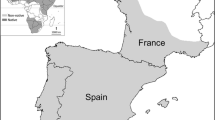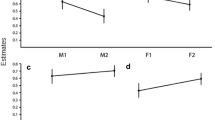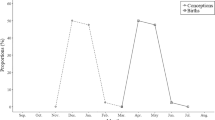Abstract
The Amami rabbit Pentalagus furnessi is an endangered leporid species and is endemic to the two subtropical islands (Amami-Oshima Island and Tokunoshima Island) in the Ryukyu Archipelago in southwestern Japan. In total, 11 breeding burrows of this rabbit were detected from 1994 to 2017 in Amami-Oshima Island. Breeding was observed from November to December in most cases and in May in one case. The litter size was one in most cases, except for one burrow which had two offspring. Two burrows were observed during the entire delivery and nursing period for two different years, and the duration of breeding (from estimated date of delivery to the date when the offspring leaves the burrow) in these two burrows was 38 and 43 days. The mother visited the burrow periodically on alternate nights, and the duration of maternal visit was relatively short. The time at which the mother visited the burrow became progressively earlier in the night as the offspring became older. Although some aspects of breeding behaviour are similar to those of other lagomorphs, the Amami rabbit has an extremely small litter size with few breeding seasons in a year, resulting in the lowest fecundity rate among the lagomorph species. This unique reproductive trait is considered to have evolved in the small subtropical island environment that has a relatively stable climate with no native carnivorous mammals.


Similar content being viewed by others
References
Alves PC, Ferrand N, Hacklander K (eds) (2008) Lagomorph biology, evolution, ecology, and conservation. Springer-Verlag, Berlin and Heidelberg
Bautista A, Martínez-Gómez M, Hudson R (2008) Mother-young and within-litter relations in the European rabbit Oryctolagus cuniculus. In: Alves PC, Ferrand N, Hacklander K (eds) Lagomorph biology, evolution, ecology, and conservation. Springer-Verlag, Berlin and Heidelberg, pp 211–223
Biodiversity Center of Japan (2010) Biodiversity of Japan. A harmonious coexistence between nature and humankind, Heibonsha
Chapman JA, Flux JEC (eds) (1990) Rabbits, hares and pikas: status survey and conservation action plan. IUCN, Gland
González-Mariscal G, Rosenblatt JS (1996) Maternal behavior in rabbits: a historical and multidisciplinary perspective. In: Rosenblatt JS, Snowdon CT (eds) Advances in the study of behavior, Parental care: evolution, mechanisms, and adaptive significance, vol 25. Academic press, New York, pp 333–360
González-Mariscal G, Caba M, Martínez-Gómez M, Bautista A, Hudson R (2016) Mothers and offspring: the rabbit as a model system in the study of mammalian maternal behavior and sibling interactions. Horm Behav 77:30–41
Hamada F (1999) Toki wo koete ikiru–Amaminokurousagi–(living in eternity–the Amami rabbit–). Shogakukan, Tokyo (in Japanese)
Japan Meteorological Agency (2019) Mean value (annual and monthly value) at Naze. http://www.data.jma.go.jp/obd/stats/etrn/view/nml_sfc_ym.php?prec_no=88&block_no=47909&year=&month=&day=&view=. Accessed 4 Mar 2019
Jilge B (1993) The ontogeny of circadian rhythms in the rabbit. J Biol Rhythm 8:247–260
Jilge B (1995) Ontogeny of the rabbit's circadian rhythms without an external zeitgeber. Physiol Bahav 58:131–140
Lloyd HG, McCowan D (1968) Some observations on the breeding burrows of the wild rabbit Oryctolagus cuniculus on the island of Skokholm. J Zool 156:540–549
Maeda T, Nakashita R, Shionosaki K, Yamada F, Watari,Y (2019) Predation on endangered species by human-subsidized domestic cats on Tokunoshima Island. Sci Rep-UK 9: 16200. https://doi.org/10.1038/s41598-019-52472-3. Accessed 24 Mar 2020
Matsuzaki T, Suzuki H, Kamiya M (1989) Laboratory rearing of the Amami rabbits (Pentalagus furnessi stone, 1900) in captivity. Exp Anim Tokyo 38:65–69
Matthee CA, van Vuuren BJ, Bell D, Robinson TJ (2004) A molecular supermatrix of the rabbits and hares (Leporidae) allows for the identification of five intercontinental exchanges during the Miocene. Syst Biol 53:433–447
Mishima S, Tanaka H, Sawai Y (1999) The biology of the habu (Trimeresurus flavoviridis). In: Rodda GH, Sawai Y, Chiszar D, Tanaka H (eds) Problem snake management: the habu and the brown treesnake. Cornell University Press, Ithaca, pp 29–43
Mykytowycz R, Gambale S (1965) A study of the inter-warren activities and dispersal of wild rabbits, Oryctolagus cuniculus (L.), living in a 45-AC paddock. Wildl Res 10:111–123
Nature’s Best Photography Asia (2017) Winners Gallery 2017. http://naturesbestphotography.asia/en/gallery/gallery-2017.html. Accessed 30 Oct 2018
Pianka ER (1970) On r- and K-selection. Am Nat 104:592–597
Rödel HG, Dausmannc KH, Starkloff A, Schubert M, von Holst D, Hudsone R (2012) Diurnal nursing pattern of wild-type European rabbits under natural breeding conditions. Mamm Biol 77:441–446
Rongstad OJ, Tester JR (1971) Behavior and maternal relations of young snowshoe hares. J Wildl Manage 35:338–346
Sako T, Uchida M, Koreeda Y (1991) Keeping and breeding of the Amami rabbit in the Kagoshima Hirakawa zoo. Anim Zoo 43:272–274 (in Japanese)
Shionosaki K, Yamada F, Ishikawa T, Shibata S (2015) Feral cat diet and predation on endangered endemic mammals on a biodiversity hot spot (Amami–Ohshima Island, Japan). Wildl Res 42:343–352
Shionosaki K, Sasaki S, Yamada F, Shibata S (2016) Changes in free-roaming cat activity following a regulation prohibiting feeding: a case study at a mountain forest near residential area in Amami City on Amami-Ohshima Island, Japan. Wildl Human Soc 3:1–13
Stearns SC (1992) The evolution of life histories. Oxford University Press, Oxford
Sugimura K (1988) The role of government subsidies in the population decline of some unique wildlife species on Amami Oshima, Japan. Environ Conserv 15:49–57
Sugimura K, Yamada F (2004) Estimating population size of the Amami rabbit Pentalagus furnessi based on fecal pellet counts on Amami Island, Japan. Acta Zool Sin 50:519–526
Sugimura K, Sato S, Yamada F, Abe S, Hirakawa H, Handa Y (2000) Distribution and abundance of the Amami rabbit Pentalagus furnessi in the Amami and Tokuno Islands, Japan. Oryx 34:198–206
Suzuki H (1985) Kurousagi no sumu mori–Amami no mori no doubututachi (the island where the Amami rabbit lives: the animals in the forests of Amami). Shinjuku Shobo, Tokyo
Suzuki M, Oumi S (2017a) Two cases of reproduction and maternal care behavior in the same breeding nest of the Amami rabbit in an orchard in Amami-Oshima Island in Japan. Mamm Sci 57:257–266 (in Japanese with English summary)
Suzuki M, Oumi S (2017b) A case study of feral cat predation on a weaning juvenile of the Amami rabbit as revealed by a camera trap survey in Amami-Oshima Island in Japan. Mamm Sci 57:241–247 (in Japanese with English summary)
Swihart RK (1984) Body size, breeding season length, and life history tactics of lagomorphs. OIKOS 43:282–290
Thompson WL (2004) Sampling rare or elusive species. Island Press, Washington DC
Virgós E, Cabezas-Díaz S, Blanco-Aguiar JA (2006) Evolution of life history traits in Leporidae: a test of nest predation and seasonality hypotheses. Biol J Linn Soc 88:603–610
Watari Y, Takatsuki S, Miyashita T (2008) Effects of exotic mongoose (Herpestes javanicus) on the native fauna of Amami-Oshima Island, southern Japan, estimated by distribution patterns along the historical gradient of mongoose invasion. Biol Invasions 10:7–17
Watari Y, Nishijima S, Fukasawa M, Yamada F, Abe S, Miyashita T (2013) Evaluating the “recovery level” of endangered species without prior information before alien invasion. Ecol Evol 3:4711–4721
Yamada F (2008) A review of the biology and conservation of the Amami rabbit (Pentalagus furnessi). In: Alves PC, Ferrand N, Hacklander K (eds) Lagomorph biology, evolution, ecology, and conservation. Springer-Verlag, Berlin and Heidelberg, pp 369–377
Yamada F (2017) Lagomorphology: biology of evasion and escaping strategy. University of Tokyo Press, Tokyo (in Japanese)
Yamada F, Cervantes FA (2005) Pentalagus furnessi. Mamm Species 782:1–5
Yamada F, Smith AT (2016) Pentalagus furnessi. The IUCN red list of threatened species 2016: e.T16559A45180151. https://doi.org/10.2305/IUCN.UK.2016-3.RLTS.T16559A45180151.en. Accessed 04 Mar 2019
Yamada F, Sugimura K (2004) Negative impact of an invasive small Indian mongoose Herpestes javanicus on native wildlife species and evaluation of a control project in Amami-Ohshima and Okinawa Islands, Japan. Glob Environ Res 8:117–124
Yamada F, Shiraishi S, Uchida T (1988) Parturition and nursing behaviours of the Japanese hare, Lepus brachyurus brachyurus. J Mamm Soc Jpn 13:59–68
Yamada F, Sugimura K, Abe S, Handa Y (2000) Present status and conservation of the endangered Amami rabbit Pentalagus furnessi. Tropics 10:87–92
Yamada F, Takaki M, Suzuki H (2002) Molecular phylogeny of Japanese Leporidae, the Amami rabbit Pentalagus furnessi, the Japanese hare Lepus brachyurus, and the mountain hare Lepus timidus, inferred from mitochondrial DNA sequences. Genes Genet Syst 77:107–116
Acknowledgements
The authors are grateful to Drs. Fumio Yamada and Mariko Suzuki who kindly reviewed the draft of the manuscript and provided several useful comments. We also thank Dr. Shosaku Hattori and Mr. Mitsutake Tabata for their advice in the field research. The corresponding author (TM) greatly appreciates the Amami Wildlife Conservation Center for allowing TM to join this research project. We would like to thank Enago (www.enago.jp) for the English language review.
Author information
Authors and Affiliations
Corresponding author
Ethics declarations
Conflict of interest
The authors declare that they have no conflict of interest.
Ethical approval
All applicable international, national and/or institutional guidelines for the care and use of animals were followed in our field research.
Additional information
Publisher’s note
Springer Nature remains neutral with regard to jurisdictional claims in published maps and institutional affiliations.
Rights and permissions
About this article
Cite this article
Hamada, F., Mizuta, T. Unique reproductive traits of the Amami rabbit Pentalagus furnessi: an endangered endemic species from southwestern Japan. Mamm Res 65, 805–813 (2020). https://doi.org/10.1007/s13364-020-00497-9
Received:
Accepted:
Published:
Issue Date:
DOI: https://doi.org/10.1007/s13364-020-00497-9




